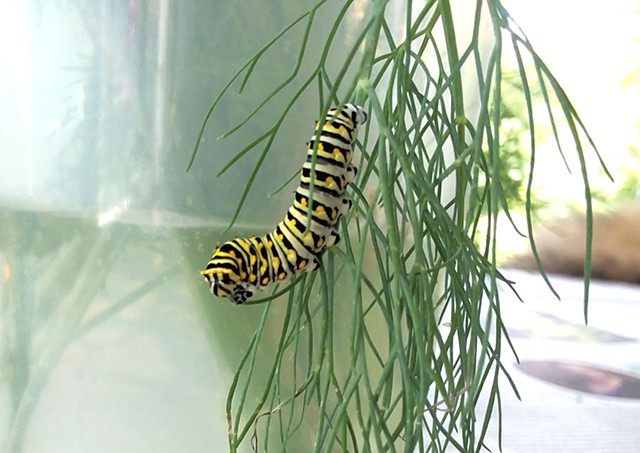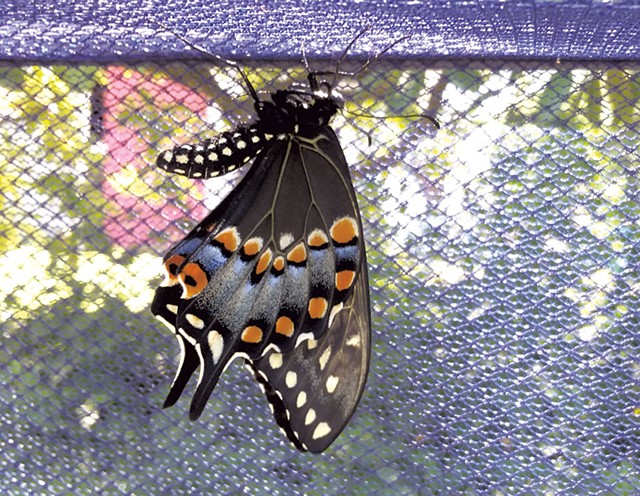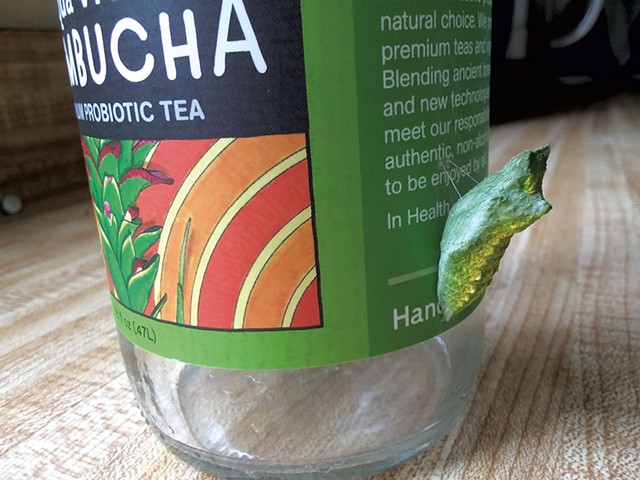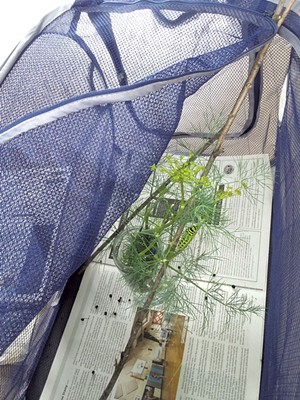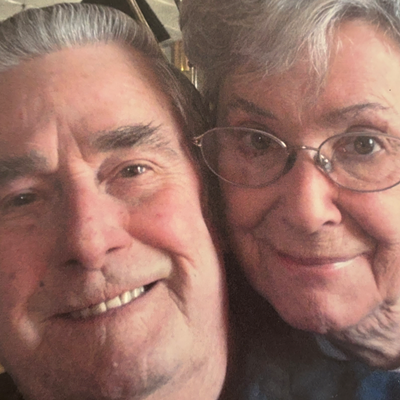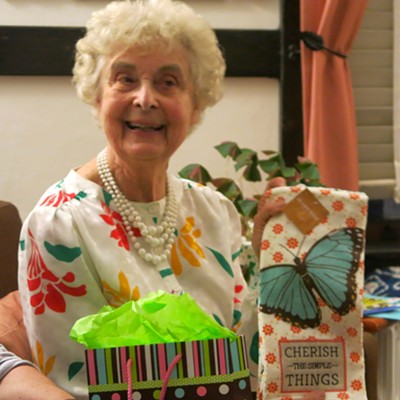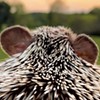Published August 18, 2020 at 10:00 a.m.
Among my favorite short stories when I was a teen was Ray Bradbury's "A Sound of Thunder." In it, a frightened time traveler falls off the approved levitating path in a prehistoric jungle and inadvertently steps on and kills a butterfly. When he and his companions return to 2055, life has changed: The English language is different, and a fascist president has won the election, not his sane opponent who had won when they'd left for the past.
I've long wondered about the sequence of events that could take place over millennia, from prehistoric dead butterfly to altered current reality. Recently, I've mused on the opposite sequence: Could six butterflies raised and released at my home in the urban outback of Vermont alter the future for the better? In my wildest dreams, could their influence reverse our current trajectory toward ecological collapse and a fascist police state?
It all began when I brought in some fresh dill from the garden. I put it in a jar of water and noticed two tiny black-and-white things. Each was barely the length of a piece of rice and remained very still on its dill frond. By morning, they had doubled in size.
A quick online search revealed that they were eastern black swallowtail instars, the first stage of the species' development from egg to butterfly. A few days later, they had turned into small green caterpillars with black bands and yellow spots. I was hooked.
Over the next week, I brought four more in from the garden (others were eaten by birds) and set up an impromptu butterfly nursery. I gave them fresh dill every two days and dumped their frass, collected on newspaper, into the garden.
Curious about whether raising these butterflies was a good idea, I spoke with Margaret Skinner, a research professor of integrated pest management at the University of Vermont. She encouraged raising them because all butterflies are helpful pollinators, and this species doesn't generally pose a threat to the common Vermont crops it eats, such as carrots, celery, parsnips and parsley.
The six caterpillars settled into an enviable routine: eat, poop, rest, repeat. While consuming the delicate herb, their maneuverings were worthy of Olympic gold. With back legs secured on a dill spear, they'd walk their front legs to the end of it, reaching the very tip while arching back nearly in half, like a gymnast touching head to feet on a balance beam. They'd chomp on the tip while walking their legs in advance back down the spear until they'd devoured it completely.
After eating their fill and stopping to rest, they'd vibrate for about a minute before expelling a round, green wad of caca, reminiscent of a loose cannon shooting a ball — or a president spouting nonsense.
As I chopped dill one day for a salad, I marveled at the fact that the caterpillars and I love the same food. Research scientists tackling human diseases work with fruit flies because about 60 percent of their genetic code is identical to that of humans. How many double helixes do we share with dill-loving caterpillars? I'm still sleuthing that one.
Once they were about two inches long, they stopped eating for a few days and remained still. Then they headed off in search of a spot worthy of attaching their chrysalis.
This caterpillar species is known to roam far and wide to find its perfect spot. And, depending on the conditions present when it turns into a chrysalis, it may emerge in a week or in the following spring. Still intent on protecting them from birds (who benefit from bird feeders and a birdbath in my yard), as soon as each showed an inkling to roam, I put it in a large mesh, nylon clothes hamper that I'd fashioned to open and close easily, with a soft towel at the bottom.
As they motored across the top of the hamper, upside down, I could see their 16 little feet moving in a perfect, synchronous pattern. It was a beautiful sight, like water rippling on a lake, or a pianist playing arpeggios.
Once in its selected spot, each caterpillar spun delicate strands to attach itself, and then bowed its head forward to form a J shape and shrank by half its size over a few days. Then, in a span of roughly four hours, its body went through a biochemical transformation from top to bottom, turning from caterpillar into chrysalis. It never spun a cocoon and disappeared; it simply morphed into a new structure, like a shape-shifting magician.
I'd never before studied insects so closely and found them fascinating and calming. The state of the country and the planet often keeps me up at night, stuck in fight-or-flight mental loops. Watching and nurturing these creatures rooted me firmly in the present, and a dance performance I created a week later based on their movements anchored me in my body, where equanimity is accessible.
Most of the butterflies emerged hours before I saw them and could bring them outside. But one emerged just minutes before I'd checked, and I watched her go through the most amazing transformation. Just out of the chrysalis, she looked drenched, and when she happened to fall to the bottom of the hamper, she crumpled in a heap like wet silk. After she had crawled back up to the top, she hung upside down, wings dangling to dry and harden. I took the hamper outside, opened it and watched. About an hour later, she crawled out on top of the hamper, opened and closed her wings for 20 minutes, flew to the nearest bush, and disappeared into the sky.
In total, three males and three females ate their way to freedom at my butterfly bodega. It's easy to tell them apart by looking at their open wings from above. Males are black with bright yellow spots; females are black with muted yellow spots and bright blue markings on the lower part of their wings.
Though I opened the hamper for some butterflies while I was working and couldn't watch them for long, each one waited until I was right there before flying off. Perhaps they were thinking, Thanks for the protection. We're off to heal the world! But they also could have been thinking, We've changed you. Go heal the world! Either way, there's hope.
The original print version of this article was headlined "Butterfly Bodega | How an accidental pollinator project lifted my spirits"
More By This Author
Speaking of...
-

Pet Project: Introducing the Winners of the 2024 Best of the Beasts Pet Photo Contest
Apr 24, 2024 -

Legislature Advances Measures to Improve Vermont’s Response to Animal Cruelty
Apr 24, 2024 -

Animal Communicator Amy Wild Wants a Word With Your Pet
Apr 24, 2024 -

A Former MMA Fighter Runs a Wildlife Rehabilitation Center in Cabot
Apr 24, 2024 -

A Burlington Celebration of Nature Helps Citizen Scientists Connect With — and Count — the City's Nonhuman Residents
Apr 24, 2024 - More »
Comments
Comments are closed.
From 2014-2020, Seven Days allowed readers to comment on all stories posted on our website. While we've appreciated the suggestions and insights, right now Seven Days is prioritizing our core mission — producing high-quality, responsible local journalism — over moderating online debates between readers.
To criticize, correct or praise our reporting, please send us a letter to the editor or send us a tip. We’ll check it out and report the results.
Online comments may return when we have better tech tools for managing them. Thanks for reading.



































